Your Backyard Wildlife Habitat: Begin in Spring to Control Fleas

Fleas, like most other insects, live everywhere around us and it’s how we manage our surroundings that helps to control their populations. Like managing mosquitoes, for instance, by eliminating still pools of water where they can breed, you can also manage the flea population around your yard without the use of toxic chemical so that fleas can’t set up a happy colony where they are ready and waiting when your pet comes outside—or even when you come outside and carry them in
Spring is the prime time to get ahead of them, so take spring cleaning in your yard as seriously as in your home and begin early. By initiating or modifying a few of the ways you care for your landscape you can eliminate nesting and breeding spaces and welcome their predators, an effect that can last all through the warm months of summer and fall.
Where Do Fleas Come From?
Fleas begin in the great outdoors, even in the nicest yard, and don’t think that simply because you don’t let your pet outside, or it’s only outside for a short while, that fleas won’t find them. Fleas are tiny and can hop amazing distances to get to a warm body for their blood meal, they can ride in on your own body though they don’t generally feed on humans, and encountering another animal that has fleas either on a walk outdoors or even at the veterinarian’s office can infest your pet without it ever setting a paw in the back yard.
But fleas are slow to wake up in the spring and are a snack for a number of predator insects. These two facts of their life cycle help you to get ahead of them.
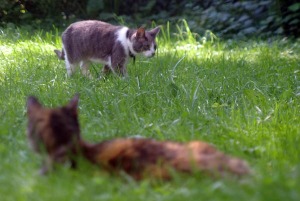
Integrated Pest Management
I’ve always taken one or more of my cats into my back yard, so I’ve always included fleas in my pest management. Adult fleas are very particular about moisture and temperature, but flea eggs can live through a lot of punishment and still hatch and carry on the next generation so they need to be managed from year to year, not just for the summer.
Aside from the dangers of insecticide toxicity, using an insecticide generally kills off all the insects in an area, not just the ones you are targeting. Where fleas are concerned, an insecticide just kills the adult fleas which are only about 10% of the total flea population. There may be some residual left to kill the eggs and larvae as they mature into adults, but with unpredictable weather it’s often washed away before it does any good.
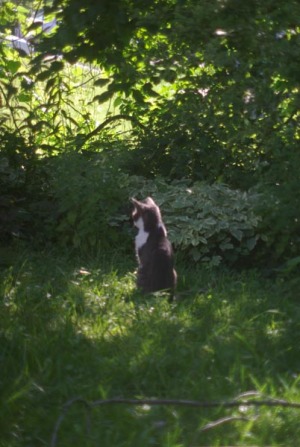
Pest insects have adapted to reproduce more quickly than their prey so the fleas will return long before their predators return, resulting in a more serious infestation than before. Without any predators you really need to keep applying the chemical, but all you do is knock down the numbers, never winning the game, and often completely kill off all predators, and not just those of fleas, while building up toxic levels in your soil which run off into local waterways, affecting more wildlife than you ever intended.
It’s obvious that species have been kept in balance for millennia by some means outside of human controls. I am a Master Gardener and began years ago to start my own plants, identify seedlings, diagnose pests and diseases and build soil. I manage my little yard as a wildlife habitat, friendly to all native species as well as the plants I choose to grow and have always called on the forces of nature to manage the populations as an ecosystem, allowing it to find its own balance, and this has worked for managing fleas as well as other insect pests in my lawn, vegetable garden, flower beds and natural areas.
The two basic steps in managing any pest that outgrows its controls is to find out where it lives and destroy that habitat to any extent possible, and then find its natural predators and encourage them to inhabit and flourish, forever if possible.

Flea Habitats
Fleas live in moist, shady areas in the yard, in the thatch in your lawn, debris piles, leaf litter, cord wood stacks and even under your deck or porch unless it’s completely dry. They’ve often overwintered in these areas and with the moisture of spring eggs start hatching as soon as it’s warm enough and shady after trees and shrubs have leafed out, about when temperatures rise above 60 degrees at night or 70 degrees during the day.
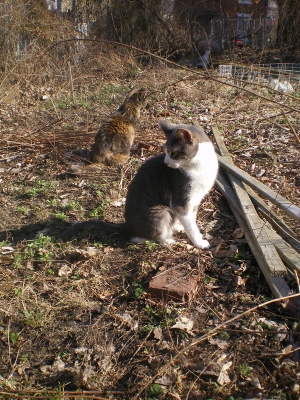
Spring Cleaning
One of the first things I do in spring, way before fleas hatch, is clear off all the debris in the yard and toss it in the compost pile, which as the materials break down heats up to a point that kills any eggs or seeds within it. I leave native plants standing for wildlife through the winter, but in spring it’s all taken down, even mowed if possible, then raked in order to remove possible pest habitat (including plant diseases which may have overwintered). If you don’t have a compost pile you can throw the material away in a bag, but just don’t keep it around, piled in a corner, or it can become a breeding ground for everything that laid eggs in it last year. This helps immensely with reducing the initial populations and you’ve also destroyed a lot of eggs and habitat for many insect pests.
This also helps to delay the onset of fleas in your yard, but they’re going to start hatching some time regardless of chemical or organic controls, so be prepared with methods to manage flea populations through their life cycle.

Manage Areas Fleas Prefer
To start with, try to minimize or eliminate damp and densely shaded areas in your yard—underneath a shrub, for instance, often a favorite place for pets to hang out on hot days because it’s cooler and the soil is a little damp. It’s absolutely flea heaven, especially if you’ve either left the leaf litter from last year or added some decorative bark or wood chip mulch. This one area can support three stages of the flea: eggs can be laid here, the larvae can live on organic matter, and they can build their cocoons here as well, hatching into adult fleas that feed on your kitty taking a nap in the shade.

My yard tends to be very damp and I also have a slug problem (that’s an understatement), and for years I’ve sprinkled diatomaceous earth (DE)in all the moist shady areas for the slugs that feast all night, also taking care of a good many fleas. This product is not soil at all but the shells of diatoms, tiny sea creatures, crushed to a fine powder. Sea shells are actually formed of minerals and while the powder looks like dust it is actually very tiny, very sharp particles that cut into the exoskeleton of the flea, causing it to dehydrate and die. It does the same thing to slugs, but other creatures, from earthworms to birds, simply digest it with no ill effect, and it’s completely a physical effect with no chemical effect at all.
Diatomaceous earth has a short-term effect outdoors, though, because it mixes with soil and other organic matter, diluting its effect, and is washed away by rain or even heavy dew, but generally sprinkling it weekly in damp shady areas through the summer is a good plan. Just make sure it’s the DE intended for gardening use NOT pool use because this has chemicals added, and wear a mask when you sprinkle it because prolonged inhalation can cause some respiratory discomfort.
At one time I used pyrethrum-based products to control fleas and other insect pests indoors and out, and while pyrethrins break down quickly in sunlight and are diluted by water, tests later showed that if they are not in conditions that break them down they can build up in soil and in the home, and can be toxic to some flora and fauna outdoors, and children and pets indoors. Many organic gardeners quit using them, though they are still sold for outdoor treatment as well as specifically flea control products. I have included a link to the CDC report at the end of this article.

Modify Your Lawn
Also manage your yard, especially your lawn, to encourage flea predators. You can apply beneficial nematodes to damp and shady areas as well as the DE, especially where you can’t change the conditions by trimming shrubs or cleaning up debris such as a bed of heavy ground cover like ivy or pachysandra, or where you’ve landscaped with mulch, sand, gravel or small stones. You may need to reapply every year or two; this was my experience, but they definitely keep populations down while they persist.
Natural Predators
You can also encourage the flea’s natural predators to come and live in your lawn and garden. Insect predators include ants, spiders and ground beetles, other species include amphibians such as toads and salamanders, reptiles such as garter snakes, and even birds that feed on the ground.
Hmmm… you don’t like spiders and snakes, and everything else sounds like something you don’t want anywhere near your house, except maybe the birds? Trust me, they are much more interested in their natural diet than they are in you, and unless you go looking you’d never know they’re there—except that you’d have fewer fleas and other pest insects generally.
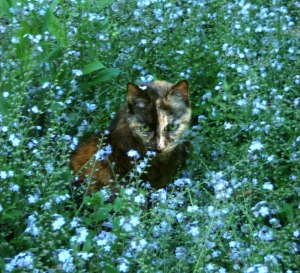
Welcome them by managing your lawn in a way that might be different from the typical grass-only buzz cut, incorporating native plants and herbs and allowing your lawn to grow a little taller. My lawn is only about half grass, while the rest is a mixture of short native plants and ground covers, plus opportunistic peppermint, pennyroyal and marjoram escaped from my herb gardens and the seedlings for next year’s forget-me-nots, daisies and other biennials and spring ephemerals. This diversity of flora encourages a diversity of fauna and eliminates large areas of one type of habitat so nothing has a chance to overpopulate.
Because I have less grass, I only have to cut the lawn about once a month after May. The native plants have a predetermined growth habit, most of them staying below six inches, and after the spring flush of growth the grass grows much more slowly. I can cut it higher than two inches, the minimum height to encourage ants and spiders, the main predators of fleas. Cutting the grass taller and less often helps the predators develop habitat and do their job on the fleas.
I also feed birds year-round, and while I always credit them with keeping vegetable and flower pests under control, I know they also peck around through the grass eating fleas.
Even if you’ve done all this you can still expect a few fleas, but you’re suddenly totally infested—what else can it be?

Wildlife
It’s that darned squirrel that hangs out on your deck, or the groundhog that’s burrowed underneath it—or the opossum that nested in your piled-up porch furniture until spring, or the little field mice and voles who sacrifice themselves to your cats in the basement.
I had sprinkled the house with diatomaceous earth, bathed and combed the cats regularly, washed everything washable, swept everywhere just about daily, removed throw rugs and pillows and such, tossed non-washable things into a hot dryer, and removed as much from my house as possible. This was all I needed to do for years and the flea population never reached an infestation.
But this year the fleas kept coming back, and increasing all the time. Where were they coming from?
I began to notice that when I walked out on my deck, my legs were immediately covered with fleas, a dozen or more at a time. Fleas don’t fly, they jump, and while they can jump far, in a situation like this you can move around and check the numbers of fleas that jump on your skin (or wear a pair of white socks so you can see them easier) to help pinpoint an area of infestation. I started stepping around the deck, knocking fleas off my legs into a cup of water, then stepping again to see where numbers seemed the worst.
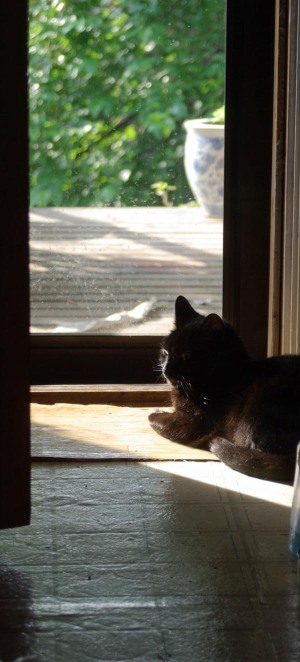
Most wild animals harbor a few fleas, and some species are typically infested. My squirrels spend about half their time scratching, and wild rabbits, chipmunks, gophers, mice and voles are also heavily infested with fleas. The squirrels hang out on my deck trying to get into the bird seed, the rabbits hop around near the basement door, and I always have a juvenile groundhog who excavates under my deck before I can trap it, chipmunks run around chirping everywhere, and field mice and voles really do show up in my basement.
And I really did have an opossum on my deck that winter. Being nocturnal, we didn’t cross paths though I saw her through the back door now and then. With the unusually heavy ice and snow I didn’t have the heart to encourage her to find another home, and I didn’t unpack all my deck furniture this year, so I have no idea how long she stayed.
It was the area right in front of the door—right over the groundhog den under the deck—and on one side of that unmoved pile of things for my deck. The groundhog had left my yard to eat someone else’s vegetable garden, but left the fleas behind. I began deconstructing the pile of porch furniture and found evidence of nesting, though not recent. In both places, a heck of a lot of fleas.
So this was the source of my infestation, right outside the door that I kept open for most of the summer, locking the screen door at night and when I was away. Fleas could hop in when I opened the door, and ride inside as I walked in and out the door. My basement door has a space at the bottom because the concrete walk just outside is lifted and the bottom of the door jammed against it, so I trimmed the door.
Normally every spring I clean off my deck, sweep, wash and apply water-based waterproofing to the wood, then move things back, but this spring’s schedule didn’t allow the time. Once I cleaned off the deck, swept and washed it as well as hosed down all the items that were there, the constant re-infestation stopped. Whew!
Some Resources for Chemical-Free Outdoor Flea Control
You can get ten pages of results or more in an internet search on flea control, diatomaceous earth, pyrethrins and so on, but I try to find studies or information from non-commercial sources to cite.
Yardener.com has a series of articles about dealing with fleas in your yard, and the article about preventing fleas in the future is especially informative—plus the site is a great resource for dealing with all sorts of pest problems in your yard.
Even though this article is from 1986, it gives a brief history of the use of diatomaceous earth from a study project at McGill University that is still applicable today about the effects and usage of DE.
http://eap.mcgill.ca/publications/eap4.htm
CDC Report on pyrethrins and pyrethroids: http://www.atsdr.cdc.gov/toxprofiles/tp155.pdf
If you’re interested in more information about Backyard Wildlife Habitats, please visit the Backyard Wildlife Habitat page on my site with articles on developing your habitat and articles showing the photos, paintings and sketches I’ve done that were inspired but my backyard.
—————————————
All images and text used on this site are copyrighted to Bernadette E. Kazmarski unless otherwise noted and may not be used in any way without my written permission. Please ask if you are interested in purchasing one as a print, or to use in a print or internet publication.


Pingback: The Creative Cat - Your Backyard Wildlife Habitat: Fall Cleanup, Bird Feeding and Fleas
Interesting post to read as I just sense how different it is from where I live! For a start we don’t have opossums, groundhogs or grey squirrels! lol. Also to have fleas in that number, I’m guessing you must live in a humid hot rural area? Austin gets his gunk on the neck every three months, so mostly he is flea and tick free … so far!!!
Carolyn, I think you have some equivalent animals, like hedgehogs and such, but I don’t think you have a marsupial like the opossum. But with the fleas, no, I live in a pretty temperate more northern area, though it’s been getting more warm and humid. Most of my cats don’t go outside but the few who do have never had fleas until recently so I have never had to put anything on them. It’s darned expensive when you have this many!
MEOWWW I know one of my former roomies at the shelter I am from had flea bites and she got real sick! Not good! I only live inside so no worries for me, whew! Paw hugs to all your furry family Savannah
Yes, I had a big problem here last year and the year before, both Mimi and Cookie had scabs all over them.
Great article! Do you use nematodes? They are great to use this time of year to get fleas.
Yes, I’ve used them in places that I cant cut or rake, like the ground covers. Everything happens at once, so you have to do it all at once.